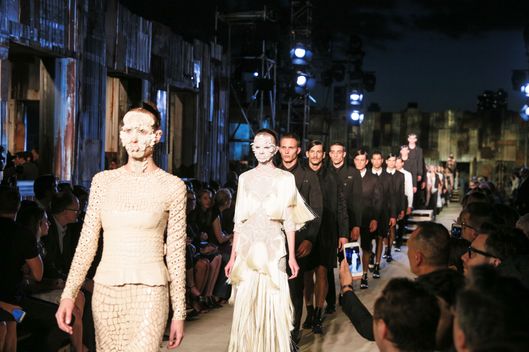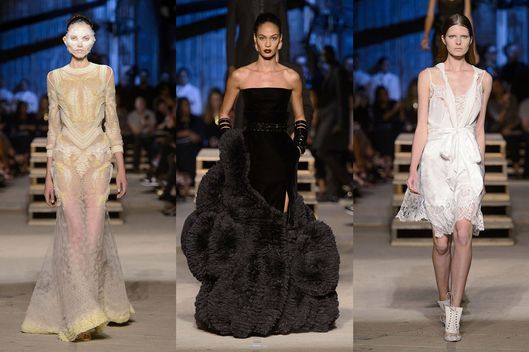Balenciaga
See it »
The symbolism was subtle, and the clothes were sensual.


The scale (more than 80 models, a star-studded audience), ambition (a collaboration with Marina Abramovic that openly referenced 9/11), and spectacle (the use of the Hudson River and lower Manhattan skyline was almost sensual) of last night’s sundown Givenchy show at Pier 26 will eclipse anything else this week.
So, doubtless, will the expense: LVMH and its arch-rival Chanel have the franchise on megashows, because they have the cash and the biggest egos. Nothing would displease Bernard Arnault, LVMH’s chairman, more than a designer who would question the wisdom of such profligacy on the anniversary of the World Trade Center attacks.
But in a way you can’t blame Arnault for such expectations. The scale of fashion has changed dramatically in the past decade. I’m not sure that clothes dominate people’s lives the way they did in another, more innocent era, but fashion shows and celebrities certainly do. In fact, I suspect the thought gnawing at many guests last night was, Why doesn’t an American designer — Ralph? — do something like this?
Riccardo Tisci’s show succeeded on many levels, but the most important was in its handling of the venue’s proximity to the 9/11 Memorial site. The music came from six different cultures and religions. The battered and rusted sheds and backdrops for the set were made from recycled materials; the rough, industrial style was consistent with previous Tisci shows. Standing atop one raised platform was a man and a small child facing (at times) the Freedom Tower, and on its twin, a man getting hosed down by an open spigot. The fact that the latter also could have been read as a metaphor for New York’s daily trials was kind of nice, though obviously Abramovic and Tisci meant the bath as a cleansing.
Religion has played a big part in Tisci’s shows, especially his early collections for Givenchy — a label once mainly known for dressing Audrey Hepburn and hordes of publicity-shy rich matrons. But on Friday night the spiritual symbolism was handled with deftness and care, and you have to believe that this was entirely due to the close collaboration between the artist and the designer.

Naturally, Givenchy rolled out the celebrities — Nicki Minaj, Julia Roberts, Kim and Kanye West, and half a dozen designers, including Michael Kors, Joseph Altuzarra, and Proenza’s Jack McCollough and Lazaro Hernandez. But the clothes were also terrific. Tisci’s collections can often project an aggressive attitude that leaves you — me — cold, if not skeptical. But this show abundantly displayed his skill with soft materials, notably lace-edged silk and delicately embroidered chiffon. There has been a lot of lace in the New York shows, but to see how Tisci used it — as the wide hem of a skimmy dress, as part of a V-shaped tunic over black trousers, in lingerie layers — was to realize that those other efforts looked pretty pedestrian. Tisci reminds people that lace is beautiful, not something to be treated like the latest technological wonder.
Tisci also had men in the show, mainly in impeccable black suiting (including shorts), and he reprised lace shirts for them, something he has done at least once before. Tisci was more focused, though, on the women, and he has never imparted female vulnerability as well as he did last night. Among the telling gestures was the gathering of satin at the shoulders and fronts of several dresses, and in masks made of what looked like scraps of lace or tiny shells. Masks can look so creepy or affected, but not here. It was also a treat to see a number of haute couture dresses, some like second skins. One gown, worn by Joan Smalls, came clustered at the hem with giant furry balls; it recalled a more colorful red-carpet number worn years ago by Zoe Saldana.
The predominately black and white clothes seemed to make reference to ceremony — weddings, First Communions, funerals. Again, this was a smart move by Tisci to incorporate the style of the clothes into the show’s more emotional themes. But the saving grace, perhaps, was that the many slip dresses and trouser combinations were sexy and contemporary. It’s still fashion that must sell.
To be fair, it was a 13 foot-long dress.
You and Rihanna Will Both Want to Invest in Dior’s New BagIt's got something for everyone.
Polo Shirts Have Turned Their Back on Ryan LochteAlong with his other major sponsors.
Ryan Lochte Will No Longer Be Paid to Wear Tiny Bathing SuitsSpeedo remains committed to transparency.
Laura Brown Is the New Editor-in-Chief of InStyleAfter 11 years at Harper’s Bazaar.
Tyra Banks Is Going to Teach a Class on Smizing at Stanford"If I see somebody not paying attention, I’m gonna call on them."
This Floating Pier Is the Most Zen Installation EverWalking on water in Italy.
Nation Is Appalled by Matt Lauer’s Nude Ankles During Ryan Lochte InterviewWhat’s the opposite of “Jeah”?
8 People at the Life of Pablo Pop-up Explain Why Kanye West Is a God"I mean, Kanye West is just Kanye West. There's not more or less you can say about Kanye West. He's just Mr. West!"
A T-shirt Is EnoughSimplicity, versatility, and cool. What more could you want?
She took a perfect pencil dive off a 30-foot yacht.
American Apparel Is Being Sued by Former WorkersAs the company considers putting itself up for sale.
A Gendered History of the Tailored SuitFrom Marlon Brando to Coco Chanel.
How Zendaya Developed Such Great Style at the Young Age of 19The star's best looks from Disney to now.
Proof That If You’re Chic Enough, a Little Federal Investigation Doesn’t MatterIs this the best they could do?
5,300-Year-Old Mummified Iceman Probably Would’ve Been a Street-Style StarHe had several different looks and was “pretty picky.”
J.Crew Has Identified 226 Shades of PinkEven more than there are shades of gray.
Gigi and Bella Hadid Merch Is Now Somehow a Thing That Is HappeningToday in Hadidiana.
Gird Your Loins for the Return of Yeezy to New York Fashion WeekThe season approaches.
This Indie Brand Had a Great Response to Ivanka TrumpWhen she bought one of their cuffs, they donated the proceeds to the Clinton campaign.